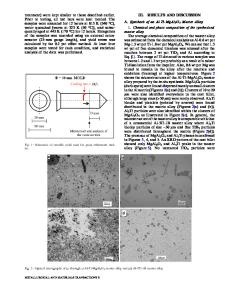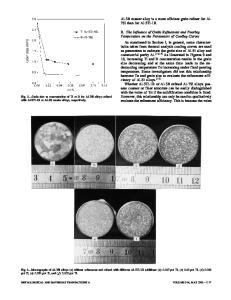Grain Refinement of a Large-Scale Al Alloy Casting by Introducing the Multiple Ultrasonic Generators During Solidificati
- PDF / 1,772,527 Bytes
- 7 Pages / 593.972 x 792 pts Page_size
- 3 Downloads / 290 Views
le Al alloy ingots, with fine microstructures, are the fundamental raw materials to manufacture the ‘‘large-scale complex component’’ through extensive deformation, which is widely used in aerospace, transportation, and energy-saving applications. Currently, the direct chill semi-continuous (DCS) casting of Al alloy is considered as one major technological method to produce large-scale castings. However, in the DCS casting of high-strength Al alloy, solidification becomes complex owing to the difficulties, i.e., large-scale temperature gradient, thermal stress, and convection. Such difficulties will lead to the inhomogeneous distribution of microstructures and solutes, resulting in severe
RUIQING LI, FANG DONG, and PINGHU CHEN, Ph.D. Students, ZHILIN LIU, Lecturer, and XIAOQIAN LI, Professor, are with the College of Mechanical and Electrical Engineering, Central South University, Changsha 410083, P.R. China, and also with the State Key Laboratory of High Performance Complex Manufacturing, Changsha 410083, P.R. China. Contact e-mail: [email protected] Manuscript submitted March 20, 2016. Article published online May 26, 2016 3790—VOLUME 47A, AUGUST 2016
cracking and macrosegregation. Therefore, the prerequisite to obtain the high-quality ‘‘large-scale complex components,’’ which are homogeneous, fine-grained, and non-cracking, is to develop advanced casting technology. Currently, adding grain refiners and/or applying physical stirring are used to improve the casting quality. Extensive work has already been conducted in the grain refinement of Al, Mg, and Zn alloys;[1–3] however, these studies were mainly focused on small-scale ingots. In terms of adding grain refiners, the quantity increases largely with increasing the size of casting, which may increase cost and contamination in casting. The physical methods include mechanical stirring,[4–6] electromagnetic stirring,[7] ultrasonic vibration,[8,9] and gas bubbles.[10] For electromagnetic stirring, the electric energy also increases simultaneously with increasing the size of casting, which can bring potential safety issues. These methods are not suitable for large-scale casting. Normally, in the large-scale casting, the ultrasonic treatment is applied to manipulate the solidification process.[9] The positive contribution of ultrasonic treatment, in refining Al, Mg, Zn, and Sn and their alloys, has been well verified.[11–18] In recent two decades, many researchers investigated the effect of single ultrasonic treatment on solidification. For instance, Wang et al. introduced ultrasonic vibration in Al-Cu alloys. It was found that both grain sizes and solute segregation were reduced/modified.[11] After ultrasonic treatment in A356 Al alloys, Jian et al.[12] and Xu et al.,[13] respectively, observed that (a) the dendrite grains were transformed into equiaxed grains, and (b) the amount of shrinkage was reduced. Alternatively, Qian et al. and Liu et al. studied the contribution of ultrasonic treatment on the solidification of Mg alloys.[14–17] Moreover, Eskin systematically investigated
Data Loading...










